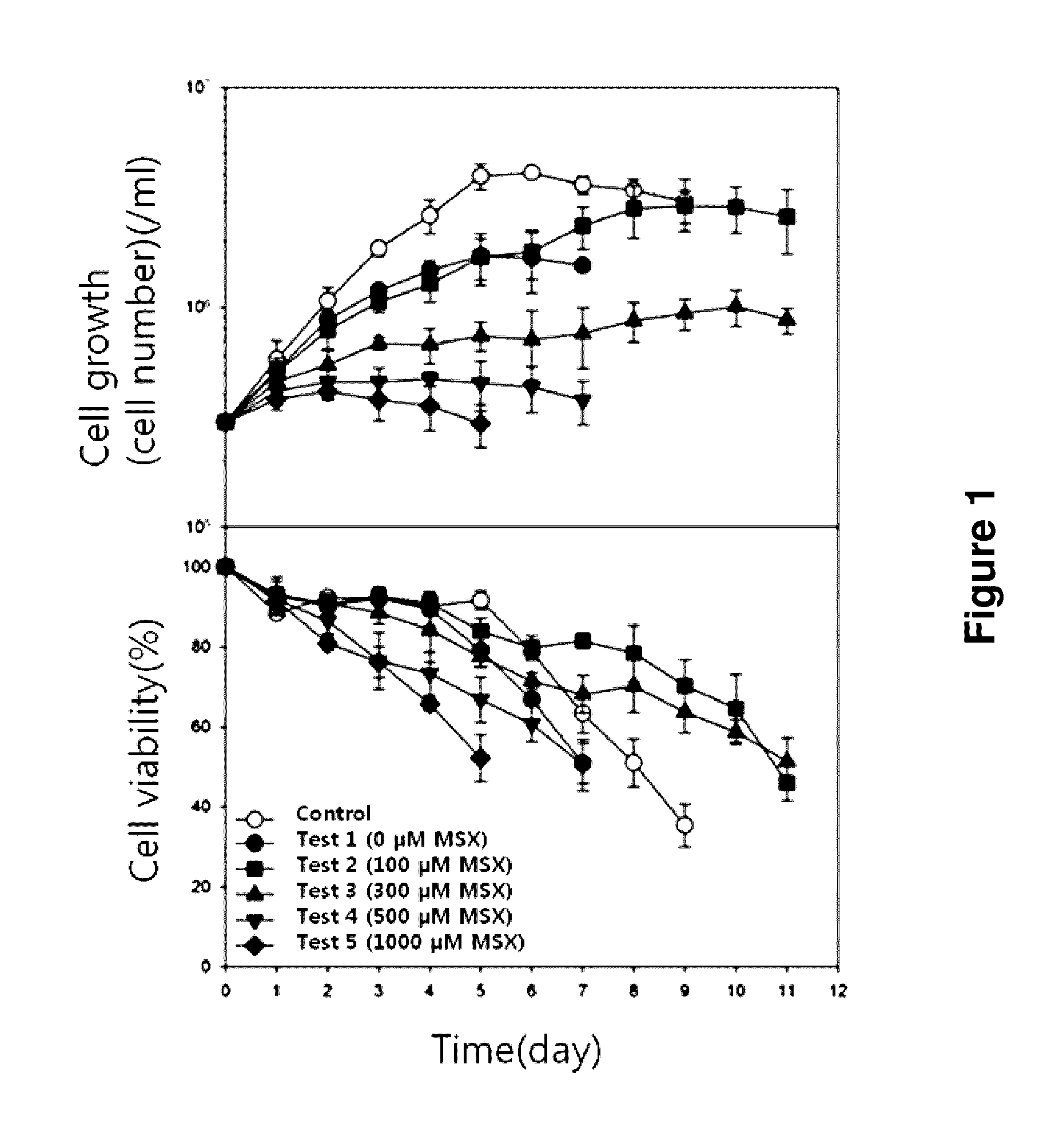Cell line containing a knockout of the glutamine synthetase (GS) gene and a method of producing target proteins using a GS knockout HEK293 cell line
- Summary
- Abstract
- Description
- Claims
- Application Information
AI Technical Summary
Benefits of technology
Problems solved by technology
Method used
Image
Examples
example 1
Confirmation of MSX Resistance of HEK293 Cell Line
[0058]The cell growth rate and the cell viability were investigated in the course of culture of HEK293 cell line with the addition of different concentrations of MSX.
[0059]Particularly, HEK293 host cells were inoculated in 50 ml of the glutamine-free EX-CELL® 293 SFM medium (Sigma), and also inoculated in the control medium supplemented with 4 mM glutamine. To the experimental group, MSX, the glutamine synthetase inhibitor, was added at the concentrations of 0 μM, 100 μM, 300 μM, 500 μM, and 1000 μM, respectively. The cell mixture was inoculated in Erlenmeyer flask at the density of 3×105 cells / ml, followed by suspension culture. 1 ml of the cell culture fluid was taken from each flask every 24 hours, followed by investigation of the cell concentration and the cell viability.
[0060]As a result, as shown in FIG. 1, GS protein was highly expressed in the HEK293 cell line, indicating that the HEK293 cell line had high resistance against ...
experimental example 1
Construction of gs Gene Knockout HEK293 Cell Line
[0061]To construct gs gene knockout HEK293 cell line, HEK293 host cells (ATCC, CRL-10852™) were first cultured in DMEM (Dulbecco's Modified Eagle's Medium, Gibco, Grand Island, N.Y., USA) supplemented with 1×GSEM (glutamine synthetase expression medium, Sigma-Aldrich, St. Louis, Mo., USA), 7% (v / v) FBS, and glutamine via adhesion culture. The adhesion-cultured HEK293 host cells were transfected with the vector encoding sgRNA ‘GGTCTCAACGGACTCACCTTAAA’ (SEQ. ID. NO: 3) targeting ‘CCAGAGTTGCCTGAGTGGAATTT’ (SEQ. ID. NO: 2) sequence of gs gene exon 4 and the vector expressing Cas9 protein by using lipofectamine 2000 (Life technology) (FIG. 2A). The cells were inoculated in 5 ml of the medium above in T-25 flask at the density of 4×105 cells / ml. 24 hours later, when the cultured cells reached 90% of confluency in the flask, 5 μg of sgRNA vector DNA, 5 μg of Cas9 protein vector DNA, and 20 μl of lipofectamine complex were added to the OptiME...
experimental example 2
Investigation of Glutamine Dependency of gs Knockout HEK293 Cell Line
[0065]The adhesion-cultured HEK293 GS-KO cell line obtained in Experimental Example 1 and the wild type HEK293 cell line were adapted to the medium supplemented with glutamine and the glutamine-free medium, followed by measurement of the cell growth and the cell viability.
[0066]Particularly, DMEM with or without glutamine was added with 1×GSEM and 10% (v / v) dFBS, resulting in the preparation of each medium with or without glutamine. The wild type HEK293 cell line and the HEK293_GS-KO cell line were inoculated in 3 ml of each medium with or without glutamine in a 6 well flask at the density of 1×105 cells / ml. The cell concentration and the cell viability were measured in each well every 24 hours.
[0067]As shown in FIG. 3, the wild type HEK293 cell line demonstrated a similar cell growth and viability either in the presence or in the absence of glutamine. However, the HEK293_GS-KO cell line did not grow in the absence...
PUM
 Login to View More
Login to View More Abstract
Description
Claims
Application Information
 Login to View More
Login to View More - R&D
- Intellectual Property
- Life Sciences
- Materials
- Tech Scout
- Unparalleled Data Quality
- Higher Quality Content
- 60% Fewer Hallucinations
Browse by: Latest US Patents, China's latest patents, Technical Efficacy Thesaurus, Application Domain, Technology Topic, Popular Technical Reports.
© 2025 PatSnap. All rights reserved.Legal|Privacy policy|Modern Slavery Act Transparency Statement|Sitemap|About US| Contact US: help@patsnap.com



